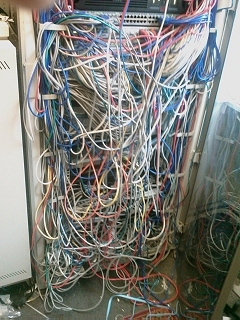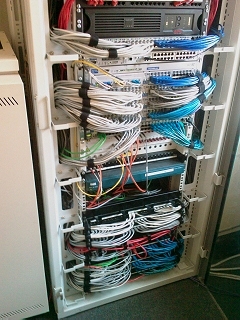What we do
Overview
We do everything from adding a new data socket in a classroom, to improving network speeds, through to providing networks in new buildings. We understand the challenges of working in schools and are very adept at ensuring there are no disruptions to learning while work is carried out. Below are some examples of the work we do:
Adding network points
We make the process as simple as possible. You show us where you want the new network point and leave the rest to us. We will work out exactly what we need to do, liaise with premises staff, and ensure we understand exactly what needs to be done. We will carry-out the work with the minimum of impact to learners, educators and support staff. We will fully test and certify the connection before completion. And we will keep the costs aligned with education budgets.
Untangling network cabinets
Network cabinets, by their very nature, often contain a lot of cables. Over time, as people add patch-leads in a hurry to solve a problem, cabinets can become untidy. An untidy cabinet is very difficult to maintain. A failure in a switch in the left-hand cabinet (below) would result in a day's down-time while cables are disconnected and mapped. In the right-hand cabinet, on the other hand, a switch can be changed in a matter of minutes. In the left-hand cabinet, RJ45 connectors become unlatched or snapped by the pressure of cables, resulting in data-point unreliability. Our approach to re-cabling cabinets is methodical and thorough.


Resolving network problems
There are many co-dependent elements of a local area network and discovering why your network is not performing as you would like is almost impossible unless you are equipped with considerable diagnostic skills, technical knowledge and experience. Our approach to diagnosing any problem is systematic, logical and tenacious. We will take the time to understand what you are experiencing, we will gain a clear picture of the structure of your network, and then we will systematically isolate the problem. We will provide you with an explanation of our findings in plain English, and recommend a solution to you.
Installing new networks
Designing an effective, resilient and future-proof network is all about careful planning. We take the time to understand your particular requirements, we ensure the design meets the needs of the BECTA Technical Specification for Institutional Infrastructure, and importantly, keep the installation costs affordable. No two network requirements are the same, and one size does not fit all. The network infrastructure must be fit for purpose but not over-engineered, otherwise purchasing, set-up and maintenance costs will escalate.
Upgrading networks
The BECTA Technical Specification for Institutional Infrastructure gives a clear standard to which network upgrades should adhere. In the main for schools, this will be a cabling and switch upgrade from CAT5 to CAT5e and 10/100 to 1Gb. However, it is not necessary to upgrade all components of the network to enjoy significant performance improvements. Upgrading 10 routes that are not at capacity will not yield any benefit whatsoever, but upgrading 1 route that is overloaded will bring an immediate benefit. We will survey your network infrastructure and recommend a phased approach to upgrading so that you only upgrade the elements as and when the change will have a direct and positive impact on performance. Clearly, this approach helps schools to keep expenditure to a minimum.
Network infrastructure audit
We audit your existing network infrastructure and will report any differences between the current network and the BECTA Technical Specification. Using this information, we will provide you with our recommendation for a phased upgrade plan so that you can budget accurately.
Overview
We do everything from adding a new data socket in a classroom, to improving network speeds, through to providing networks in new buildings. We understand the challenges of working in schools and are very adept at ensuring there are no disruptions to learning while work is carried out. Below are some examples of the work we do:
Adding network points
We make the process as simple as possible. You show us where you want the new network point and leave the rest to us. We will work out exactly what we need to do, liaise with premises staff, and ensure we understand exactly what needs to be done. We will carry-out the work with the minimum of impact to learners, educators and support staff. We will fully test and certify the connection before completion. And we will keep the costs aligned with education budgets.
Untangling network cabinets
Network cabinets, by their very nature, often contain a lot of cables. Over time, as people add patch-leads in a hurry to solve a problem, cabinets can become untidy. An untidy cabinet is very difficult to maintain. A failure in a switch in the left-hand cabinet (below) would result in a day's down-time while cables are disconnected and mapped. In the right-hand cabinet, on the other hand, a switch can be changed in a matter of minutes. In the left-hand cabinet, RJ45 connectors become unlatched or snapped by the pressure of cables, resulting in data-point unreliability. Our approach to re-cabling cabinets is methodical and thorough.


Resolving network problems
There are many co-dependent elements of a local area network and discovering why your network is not performing as you would like is almost impossible unless you are equipped with considerable diagnostic skills, technical knowledge and experience. Our approach to diagnosing any problem is systematic, logical and tenacious. We will take the time to understand what you are experiencing, we will gain a clear picture of the structure of your network, and then we will systematically isolate the problem. We will provide you with an explanation of our findings in plain English, and recommend a solution to you.
Installing new networks
Designing an effective, resilient and future-proof network is all about careful planning. We take the time to understand your particular requirements, we ensure the design meets the needs of the BECTA Technical Specification for Institutional Infrastructure, and importantly, keep the installation costs affordable. No two network requirements are the same, and one size does not fit all. The network infrastructure must be fit for purpose but not over-engineered, otherwise purchasing, set-up and maintenance costs will escalate.
Upgrading networks
The BECTA Technical Specification for Institutional Infrastructure gives a clear standard to which network upgrades should adhere. In the main for schools, this will be a cabling and switch upgrade from CAT5 to CAT5e and 10/100 to 1Gb. However, it is not necessary to upgrade all components of the network to enjoy significant performance improvements. Upgrading 10 routes that are not at capacity will not yield any benefit whatsoever, but upgrading 1 route that is overloaded will bring an immediate benefit. We will survey your network infrastructure and recommend a phased approach to upgrading so that you only upgrade the elements as and when the change will have a direct and positive impact on performance. Clearly, this approach helps schools to keep expenditure to a minimum.
Network infrastructure audit
We audit your existing network infrastructure and will report any differences between the current network and the BECTA Technical Specification. Using this information, we will provide you with our recommendation for a phased upgrade plan so that you can budget accurately.


